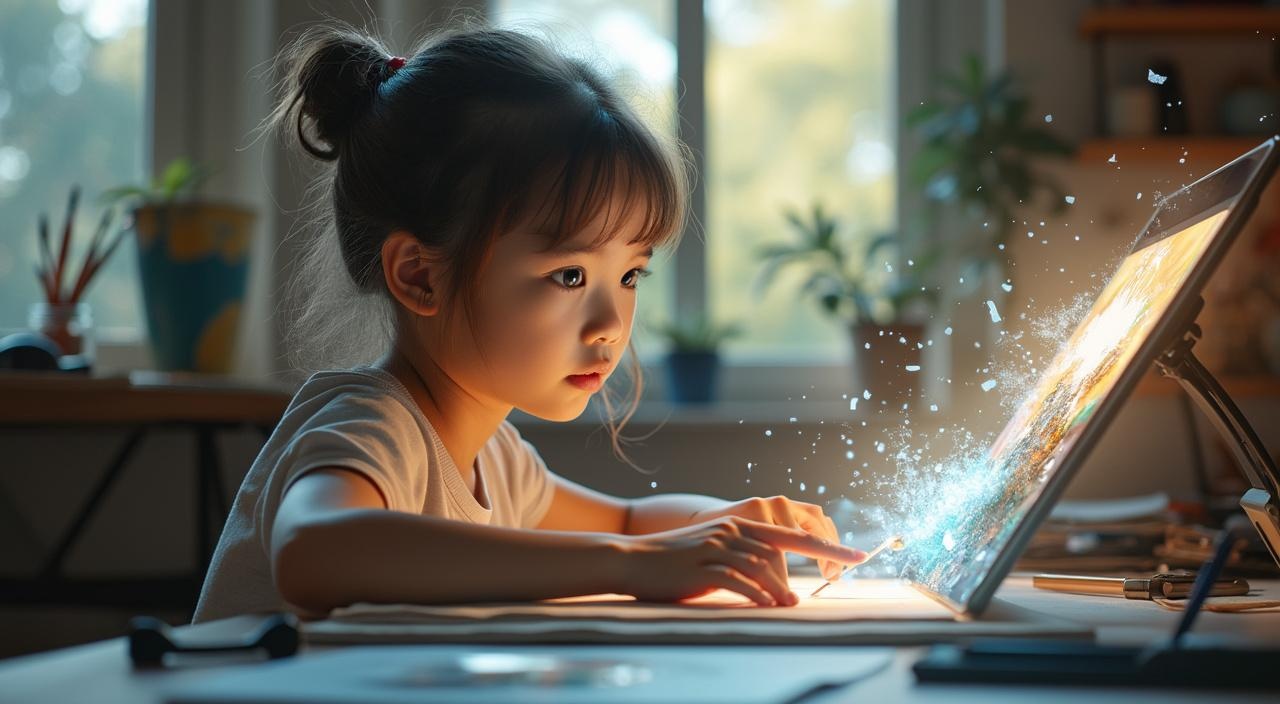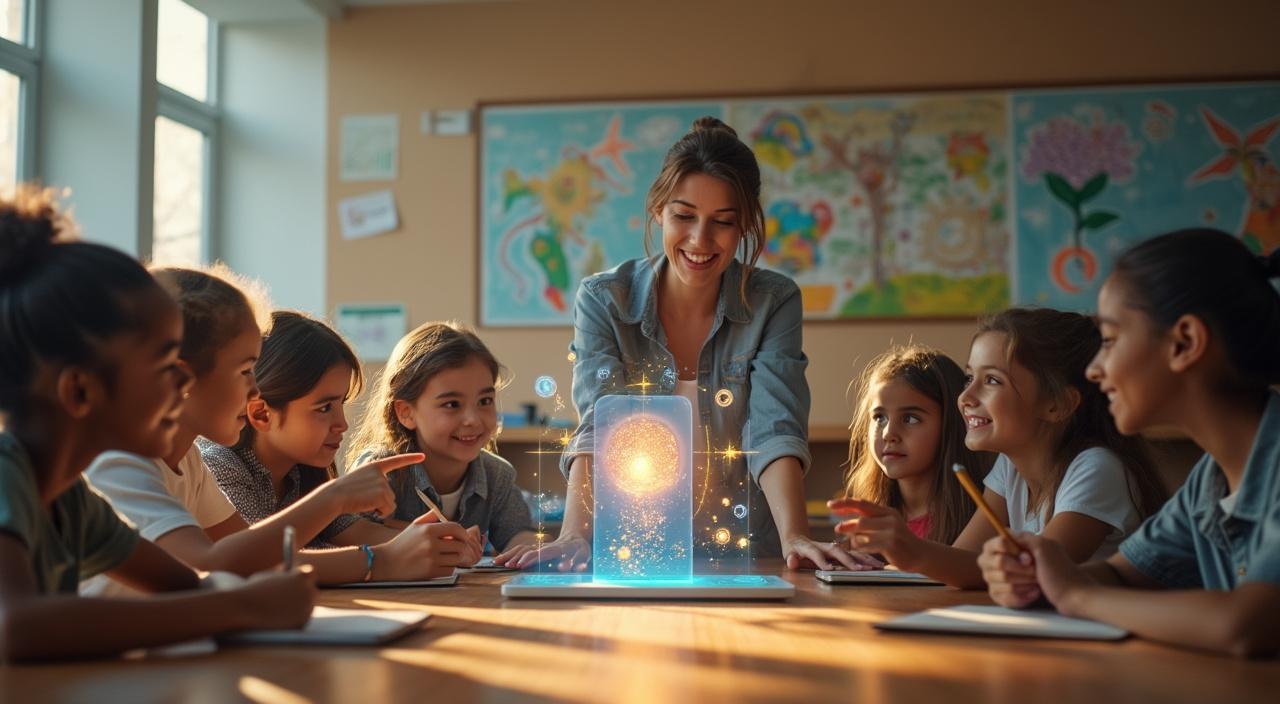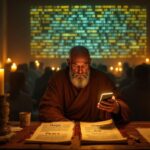AI has sparked a creative revolution among young learners, changing how they interact with technology. Instead of just consuming digital content, children now actively create it using AI-powered tools that remove traditional barriers. These tools give kids the freedom to craft stories, generate artwork, and compose music with remarkable ease and accessibility.
Key Takeaways:
- AI empowers children to become digital creators, with 44% actively engaging through educational and creative platforms
- Creative tools like story generators, art platforms, and music creation software are expanding kids’ expressive capabilities
- Students view AI as a collaborative partner that amplifies—not replaces—human imagination
- Personalized AI learning can boost student engagement by 30-50%
- Guided integration by educators is crucial for responsible and innovative AI creativity
Digital Playgrounds: Where AI Meets Childhood Creativity
Kids don’t just consume technology anymore—they’re creating with it. The statistics tell a remarkable story: 44% of children actively engage with AI through educational tools and creative platforms. I’ve watched my own clients’ children move from passive screen watchers to active digital artists and storytellers.
Creative Platforms Reshaping Young Minds
These AI-powered tools are changing how kids express themselves:
- Story generators like Storybird help children craft narratives beyond their writing level
- Art tools including DALL-E enable visual storytelling without traditional artistic barriers
- Music creation platforms such as Google’s Magenta let kids compose original soundtracks
Here’s what I find fascinating: children approach these tools without the fear adults carry. They experiment fearlessly, mixing human imagination with AI capabilities. While we worry about students misusing AI, kids are actually pioneering new forms of creative expression.
The result? A generation that sees AI as a creative partner, not a replacement for human ingenuity.
Unleashing Limitless Creative Potential
Kids today aren’t just consuming content—they’re creating worlds. AI transforms ordinary classroom moments into extraordinary creative experiences that would make Walt Disney jealous.
The Numbers Don’t Lie
Personalized learning through AI boosts student engagement by 30-50%. I’ve watched classrooms come alive when students realize they can bring their wildest ideas to reality. One eighth-grader recently created an entire graphic novel about climate change using AI-powered illustration tools. Her teacher told me it was the most engaged she’d ever seen that student.
Beyond Traditional Boundaries
AI doesn’t replace imagination—it amplifies it. Students can now express complex mathematical concepts through interactive stories or turn historical events into immersive experiences. Here’s what I’m seeing work:
- AI-assisted collaborative storytelling where each student adds chapters
- Comic creation combining student narratives with AI-generated visuals
- Interactive poetry that responds to reader emotions
The magic happens when technology becomes invisible and creativity takes center stage. These aren’t just digital natives anymore—they’re digital architects.

Guided Integration: The Teacher’s Critical Role
Teachers have become the architects of AI-enhanced learning, with 60% already weaving artificial intelligence into their daily classroom practices. You’re not just adding another tech tool to your arsenal—you’re reshaping how young minds approach creativity and problem-solving.
The secret lies in establishing clear boundaries before letting students loose with AI tools. I’ve watched classrooms transform when educators set proper guidelines from day one. Students need to understand that AI amplifies their imagination rather than replacing it.
Building Your AI Integration Framework
Your implementation strategy should follow these practical steps:
- Select age-appropriate AI tools that match your students’ developmental stage and learning objectives
- Create structured creative assignments that require both AI assistance and human insight
- Facilitate reflective discussions about the collaboration between artificial and human intelligence
The magic happens during those reflective conversations. Students begin to recognize their unique contributions when they compare their original ideas with AI-generated content. One teacher told me her students started saying, “The AI gave me a starting point, but I made it mine.”
Don’t expect perfection immediately. Integration takes time, and you’ll discover what works through trial and adjustment. Some students will embrace AI tools naturally, while others need more guidance to find the balance between digital assistance and personal creativity.
Your role has evolved into something more nuanced—part facilitator, part digital literacy coach, and part creativity mentor. The AI revolution demands this new approach to education, and you’re leading the charge in preparing students for their creative futures.

Balancing Technology and Human Creativity
Smart educators know the secret isn’t choosing between AI and human imagination—it’s finding the sweet spot where both thrive. I’ve watched classrooms transform when teachers stop treating AI as either savior or villain and start using it as a creative catalyst.
Design Hybrid Creative Assignments
The magic happens when students become AI directors rather than passive consumers. I recommend starting projects with AI-generated foundations—maybe a rough story outline or basic artwork—then challenging students to transform these outputs into something uniquely theirs. One teacher I know has students generate three AI story beginnings, then pick the weakest one to rewrite completely. Students quickly learn that AI gives you raw material, not finished masterpieces.
Cultivate Critical AI Evaluation Skills
Teaching students to critique AI outputs builds both analytical thinking and creative confidence. Here’s what works in practice:
-
• Ask students to identify what’s missing from AI-generated content
• Have them explain why certain AI suggestions feel “off” or incomplete
• Challenge them to improve AI outputs using their own experiences and perspectives
• Create peer review sessions where students compare AI-assisted work with purely human creations
The goal isn’t perfection—it’s developing that internal compass that distinguishes between helpful AI assistance and creative crutches. Students who learn to thoughtfully integrate AI tools while maintaining their creative voice will dominate tomorrow’s creative landscape. They’re not just using technology; they’re directing it.
Safety, Privacy, and Ethical Considerations
Smart parents don’t hand kids a loaded water gun without teaching them where to aim it. The same logic applies to AI creativity tools.
Building Digital Defense Systems
Age-appropriate content filters act as your first line of defense. I’ve seen too many promising creative sessions derail because inappropriate material slipped through. Choose platforms that actively monitor and curate content for young users.
Data privacy deserves equal attention. Kids create personal content that reveals their thoughts, interests, and creative patterns. Protecting family privacy starts with understanding what data these tools collect and how they store it.
Creating Ethical Young Creators
Digital citizenship training transforms kids from passive consumers into responsible creators. Teaching them to cite AI assistance, respect copyright, and understand bias in AI outputs builds character alongside creativity.
Parent involvement makes everything stick better. Host information sessions that demonstrate these tools alongside safety protocols. When parents understand the technology, they become partners in nurturing responsible digital creativity.
The Future of Creative Learning
I’ve watched countless educators struggle with AI integration, but the smart ones aren’t fighting the tide—they’re riding it. AI literacy can’t remain an afterthought in our schools. Students need these digital creation skills now, not after graduation.
Educators are already discovering that AI amplifies student creativity rather than replacing it. The magic happens when teachers, parents, and tech developers work together. This isn’t about dumping technology on kids and hoping for the best.
Building Tomorrow’s Creative Thinkers
Success requires developing these core competencies in young learners:
- Critical evaluation of AI-generated content and sources
- Collaborative problem-solving using digital tools
- Creative storytelling enhanced by AI assistance
- Ethical reasoning about technology’s impact
Students who learn to work alongside AI today become the innovative leaders of tomorrow. Alpha School’s model proves this approach works. The question isn’t whether AI belongs in education—it’s how quickly we can adapt our teaching methods to prepare genuinely empowered digital creators.

Sources:
– ABC7 Amarillo: Is AI Making Students Less Smart?
– World Economic Forum: Why AI Literacy is Now a Core Competency in Education
– The Classic Journal: Supervising AI in Education
– Smodin Blog: AI in Education Statistics: Interesting Facts to Consider








